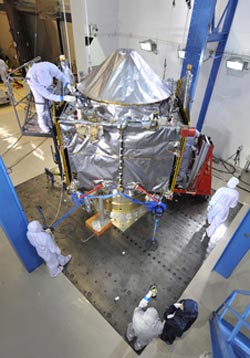Particles and Fields Package Integrated on Upcoming Mars-Bound Spacecraft

NASA’s MAVEN spacecraft undergoes acoustics testing on Feb. 13, 2013 at Lockheed Martin Space Systems’ Reverberant Acoustic Laboratory. The environmental test simulates the maximum sound and vibration levels the spacecraft will experience during launch. MAVEN is the next mission to Mars and will be the first mission devoted to understanding the Martian upper atmosphere. Credit: Lockheed Martin<br>
The Solar Wind Electron Analyzer (SWEA) was the last of the six instruments to be delivered, and was integrated late last week at Lockheed Martin in Littleton, Colo. SWEA measures the properties of electrons at Mars, one electron at a time, and can process up to one million events per second.
The other instruments in the package had been delivered earlier. In addition to the SWEA instrument, the package includes the Solar Wind Ion Analyzer (SWIA), Suprathermal and Thermal Ion Composition (STATIC), Solar Energetic Particle (SEP), Langmuir Probe and Waves (LPW), Magnetometer (MAG), and a data-processing unit.
“The Particles and Fields Package is designed to study the solar wind interaction with Mars and the structure and dynamics of Mars' ionosphere, including the influence of Mars' strongly magnetized crust,” said David L. Mitchell, SWEA instrument lead and coordinator for the full package, from the University of California, Berkeley/Space Sciences Laboratory (SSL). “The package measures solar ultraviolet flux, solar wind properties, and energetic particles produced in solar storms to help us understand how the Sun influences the upper atmosphere and drives atmospheric escape.”
The package was built by the University of California, Berkeley/Space Sciences Laboratory (SSL) with support from the University of Colorado Boulder/Laboratory for Atmospheric and Space Physics (CU/LASP) and NASA's Goddard Space Flight Center.
“The final components of the science payload are coming together, so we’re getting closer to being ready for launch,” said Bruce Jakosky, MAVEN principal investigator from CU/LASP. “I look forward to the exciting and diverse science results that the Particles and Fields Package instruments will provide.”
The MAVEN spacecraft will carry two other instrument suites. The Remote Sensing Package, built by CU/LASP, will determine global characteristics of the upper atmosphere and ionosphere. The Neutral Gas and Ion Mass Spectrometer, provided by NASA Goddard, will measure the composition and isotopes of neutral ions.
“We’re in the home stretch now of completing the assembly and test of the spacecraft. With the full complement of Particles and Fields Package instruments now onboard the spacecraft, we are in a very good position for delivering the spacecraft to the launch site on schedule in August”, said David F. Mitchell, MAVEN project manager from NASA’s Goddard Space Flight Center in Greenbelt, Md.
MAVEN is scheduled for launch in November, 2013. It is the first spacecraft devoted to exploring and better understanding the Martian upper atmosphere. MAVEN will investigate the role that loss of Mars' atmosphere to space played in determining the history of water on the surface.
MAVEN’s principal investigator is based at the University of Colorado at Boulder's Laboratory for Atmospheric and Space Physics. The university provides science instruments and leads science operations, and Education and Public Outreach. NASA's Goddard Space Flight Center manages the project and provides two of the science instruments for the mission. Lockheed Martin of Littleton, Colo., built the spacecraft and is responsible for mission operations. The University of California at Berkeley Space Sciences Laboratory provides science instruments for the mission. NASA’s Jet Propulsion Laboratory, Pasadena, Calif., provides navigation support, the Deep Space Network, and the Electra telecommunications relay hardware and operations. Goddard Release: 13-014
Nancy Neal Jones
NASA's Goddard Space Flight Center, Greenbelt, Md.
301-286-0039
Nancy.N.Jones@nasa.gov
Media Contact
All latest news from the category: Physics and Astronomy
This area deals with the fundamental laws and building blocks of nature and how they interact, the properties and the behavior of matter, and research into space and time and their structures.
innovations-report provides in-depth reports and articles on subjects such as astrophysics, laser technologies, nuclear, quantum, particle and solid-state physics, nanotechnologies, planetary research and findings (Mars, Venus) and developments related to the Hubble Telescope.
Newest articles

Solving the riddle of the sphingolipids in coronary artery disease
Weill Cornell Medicine investigators have uncovered a way to unleash in blood vessels the protective effects of a type of fat-related molecule known as a sphingolipid, suggesting a promising new…

Rocks with the oldest evidence yet of Earth’s magnetic field
The 3.7 billion-year-old rocks may extend the magnetic field’s age by 200 million years. Geologists at MIT and Oxford University have uncovered ancient rocks in Greenland that bear the oldest…

Decisive breakthrough for battery production
Storing and utilising energy with innovative sulphur-based cathodes. HU research team develops foundations for sustainable battery technology Electric vehicles and portable electronic devices such as laptops and mobile phones are…





















